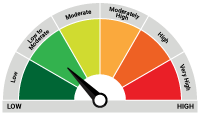Debt monthly view for February 2022
Posted On Thursday, Mar 10, 2022
Bond market has been on a roller coaster ride in 2022 so far. The 10-year government bond yield which was hovering around 6.35% during December 2021, spiked to 6.95% (on February 4, 2022) in the aftermath of Union Budget; and is currently trading around 6.80% (March 2, 2022).
The selling in the bond market can be attributed to -
- hawkish US FED policy projecting series of rate hikes and liquidity reduction
- rising crude oil and other commodity prices
- higher than expected fiscal deficit and market borrowings by the Central Government
To start with, we expected bond yields to rise gradually with the RBI pursuing a normalization of the monetary policy by reducing the liquidity surplus and hiking interest rates.
Interest rates/bond yields did move up. While the RBI held the policy rates unchanged and delivered an ultra-dovish policy statement indicating continuation of the current easy monetary policy regime for a longer period.
This provided a shy of relief to the ailing bond markets but failed to make any notable impact on the weak investor sentiment. Clearly, the domestic monetary policy has taken a backseat amidst all the chaos on the global front.
The ongoing war between the Russia and Ukraine has added another layer of uncertainty in the market. Its direct impact is visible in the fast-spiraling crude oil prices which has already risen by ~39% since start of this year and currently trading above USD 110 per barrel.
Russia plays an outsized role in the global oil market. It is the largest exporter of oil in the world accounting for almost 8% of total world oil supply. Thus, a prolonged war or stricter economic sanctions on Russian energy and financial sectors could put significant upward pressure on crude oil prices.
India imports more than 85% of its total crude oil consumption. This makes the Indian economy and the Indian bond markets vulnerable to an oil price shock.
With rising crude oil prices, imports bills will rise putting pressure on the current account balance. It also fuels inflation and dents the government balance sheet by increased fuel subsidy or revenue loss in case of fuel tax cut.
For every US$ 10/bbl increase in the crude oil price, import bill increases by US$ 20 billion and the current account deficit widens by ~0.4% of GDP. If this passed on to domestic petrol and diesel prices completely, it can increase the consumer price inflation by 40-50 basis points over the period.
From the bond market’s perspective, this is a bad macro setup. If crude oil price continues to rise, we should expect bond yields to move higher despite the continuation of easy monetary policy.
The RBI itself has not factored in this high crude oil prices in their inflation and growth forecasts while framing the monetary policy. If oil prices sustain where they are now, the RBI will find it difficult to maintain an accommodative monetary policy. Thus, crude oil price remains the biggest risk for the Indian bond markets.
Going ahead the bond market will also respond to the domestic demand supply situation which has worsened significantly due to elevated market borrowings by the government.
The central government has pegged its gross market borrowing in FY 2022-23 at Rs. 14.95 trillion vs 10.46 trillion in FY22. To recall, the government borrowing was around Rs. 7.1 trillion in FY20 (before the pandemic) which jumped to Rs. 12.6 trillion in FY21. The point to note here is that government borrowing has more than doubled in the last three years. It is already much higher than natural market appetite.
Notwithstanding this fact, the bond market was well behaved in the last two years due to – (1) easy monetary policy and increasing liquidity surplus, (2) large bond purchases by the RBI and (3) increased demand from banks due to HTM relaxation.
The RBI had increased the HTM limit for banks investment in government securities which means they can hold higher proportion of bonds without worrying about their market prices.
Going forward, incremental monetary easing (rate cuts or liquidity addition) looks unlikely. Instead, the RBI may look to reduce the liquidity and hike rates in the second half of this year.
Banks’ incremental demand for bonds may also come down as they are already sitting on a large investment book. As of February 11, 2022, bank’s investment in government securities was at ~29% of total deposits as against the regulatory requirement of 18%.
We estimate a total demand shortfall of Rs. 3-5 trillion in FY23.
The longer maturity bonds are at higher risk of demand supply imbalance as the duration of the government’s market borrowing may rise in light of heavy bond maturities over next 4 years.
In this macro backdrop, bond yields are expected to rise. However, the yield curve is still very steep in the unto 5-year maturity segment. With the overnight cash rate (Tri-party Repo) near 3.4%, 1yr Gsec trading around 4.4% and 5-year Gsec trading around 6.1%, defensive positioning and cash holding comes with a substantial loss in interest accruals.
In this environment the 2–5 year part of the Gsec curve offers the critical balance between the duration and accrual. It also offers a decent rolldown potential which can offset some of the rise bond yields going forward.
At the longer end, valuations look desirable from their historical comparisions. But, it may not provide enough protection on the downside due to large demand supply imbalance.
Bulk of our holding in the Quantum Dynamic Bond Fund is in the 2-5 years maturity segment. Given the current geopolitical uncertainty, we are also holding a significant cash position in the fund to provide cushion against market sell off.
We stand vigilant to react and change the portfolio positioning in case our view on the market changes.
From investors’ perspective, we believe a combination of liquid to money market funds and short term debt funds and/or dynamic bond funds with low credit risks should remain as the core fixed income allocation.
We advise bond fund investors to have longer holding period to ride through any intermittent turbulence in the market.
Source: Worldometer.info
| Name of the Scheme | This product is suitable for investors who are seeking* | Riskometer |
| Quantum Dynamic Bond Fund An Open-ended Dynamic Debt Scheme Investing Across Duration. A relatively high interest rate risk and relatively low credit risk. | • Regular income over short to medium term and capital appreciation • Investment in Debt / Money Market Instruments / Government Securities |  Investors understand that their principal will be at Low to Moderate Risk |
The Risk Level of the Scheme in the Risk O Meter is based on the portfolio of the scheme as on February 28, 2022.
| Potential Risk Class Matrix – Quantum Dynamic Bond Fund | |||
| Credit Risk → | Relatively Low | Moderate (Class B) | Relatively High (Class C) |
| Interest Rate Risk↓ | |||
| Relatively Low (Class I) | |||
| Moderate (Class II) | |||
| Relatively High (Class III) | A-III | ||
Disclaimer, Statutory Details & Risk Factors:
The views expressed here in this article / video are for general information and reading purpose only and do not constitute any guidelines and recommendations on any course of action to be followed by the reader. Quantum AMC / Quantum Mutual Fund is not guaranteeing / offering / communicating any indicative yield on investments made in the scheme(s). The views are not meant to serve as a professional guide / investment advice / intended to be an offer or solicitation for the purchase or sale of any financial product or instrument or mutual fund units for the reader. The article has been prepared on the basis of publicly available information, internally developed data and other sources believed to be reliable. Whilst no action has been solicited based upon the information provided herein, due care has been taken to ensure that the facts are accurate and views given are fair and reasonable as on date. Readers of this article should rely on information/data arising out of their own investigations and advised to seek independent professional advice and arrive at an informed decision before making any investments.
Mutual fund investments are subject to market risks read all scheme related documents carefully.
Please visit – www.quantumamc.com/disclaimer to read scheme specific risk factors. Investors in the Scheme(s) are not being offered a guaranteed or assured rate of return and there can be no assurance that the schemes objective will be achieved and the NAV of the scheme(s) may go up and down depending upon the factors and forces affecting securities market. Investment in mutual fund units involves investment risk such as trading volumes, settlement risk, liquidity risk, default risk including possible loss of capital. Past performance of the sponsor / AMC / Mutual Fund does not indicate the future performance of the Scheme(s). Statutory Details: Quantum Mutual Fund (the Fund) has been constituted as a Trust under the Indian Trusts Act, 1882. Sponsor: Quantum Advisors Private Limited. (liability of Sponsor limited to Rs. 1,00,000/-) Trustee: Quantum Trustee Company Private Limited. Investment Manager: Quantum Asset Management Company Private Limited. The Sponsor, Trustee and Investment Manager are incorporated under the Companies Act, 1956.
Related Posts
-

Debt Monthly for December 2025
Posted On Tuesday, Dec 02, 2025
As we approach the end of the calendar year, we find ourselves at a pivotal moment, with the market split on the likelihood of an upcoming rate cut.
Read More -

Debt Monthly for November 2025
Posted On Tuesday, Nov 04, 2025
October 2025 in a Nutshell: Monetary Policy and Demand–Supply
Read More -

Debt Monthly for October 2025
Posted On Friday, Oct 03, 2025
September was a pivotal month for fixed income markets, both globally and domestically.
Read More



